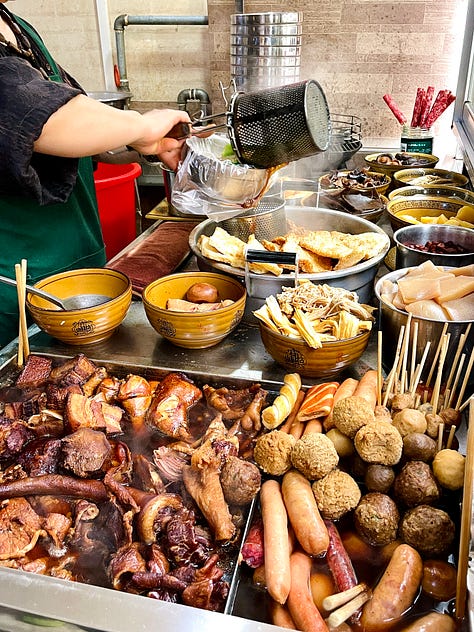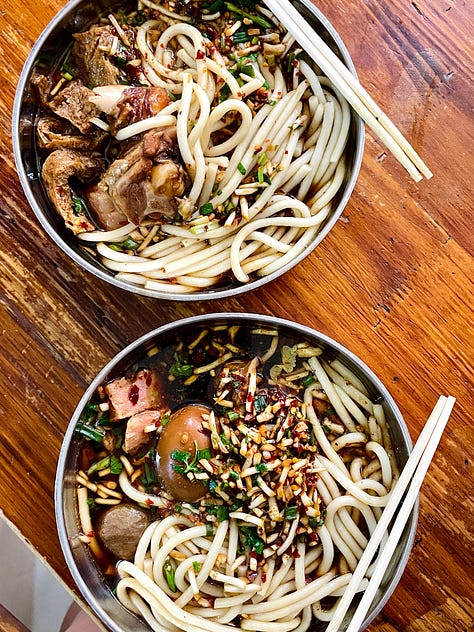Master Stock Noodle Soup (卤粉)
...is one of those obvious seeming ideas, but only popped up in Guizhou.
Lushui — Chinese master stock — is something you can find all across the country. It might be a bit more concentrated in the south (Cantonese and Teochew-style master stocks are quite famous)… but there’s equally Sichuan-style master stock, Yunnan-style master stock, Henan-style master stock. ‘Stewing meat and tofu for hours in heavily spiced, seasoned liquid’ is one of those good ideas that no Chinese cuisine seems to have a monopoly on.
Lushui — Chinese master stock — noodle, on the other hand is an idea that’s very unique to the Guizhou province.
You can find Lufen — i.e., Master Stock Rice Noodle — joints in pockets around the province, centered around in the cities of Anshun and Qianxi. At first glance from the street, they look similar enough to a Lushui shop you could find in Guangzhou:



Like Lushui shops around the country, what you do is first order up your desired smorgasbord of stewed stuff: pork belly, tofu jerky, hotdog, whatever. But in these Guizhou shops, the stewed meat and such acts as the add-ins for the soup — after snipping them up, the vendor then proceeds by simmering rice noodles in the master stock itself. The bowl’s then finished with a big scoop of the master stock as the ‘soup’, and hit with an (optional) spoonful of a unique local chili topping.
It's just… a really smart evolution of the concept of the ‘lushui shop’. Predicting trends is always a fools errand, but with Guizhou food becoming increasingly popular in Shanghai and Shenzhen these days, it wouldn’t surprise me if this concept ended up having some reach.
Regardless, it’s a fantastic noodle soup — I heavily recommend giving it a whirl.
How to Adjust Commercialized Noodle Soups to the Home Kitchen
Lufen is, of course, a commercialized concept: at least as far as we know, Guizhou people aren’t exactly whipping master stock noodles at home on the regular. So we wanted to make a couple logistical adjustments for our recipe.
When we first started the channel, we dutifully tried to mimic the exact ‘soup noodle serving style’ that you’d see on the street. Cultural fidelity, after all, has always been important to us. But striving to create individually completed bowls of, say, Chongqing noodles for your guests creates a couple issues:
Generally, at home everyone eats at once. It most home set-ups your first batches of noodles will get cool (and potentially soggy) by the time everyone sits down at the table.
Street food noodles are designed to be a quick lunch or a substantive snack — something to eat on the go. There can be something deeply unsatisfying about cooking a dish for (potentially) hours, simply to have the thing get devoured in minutes.
But up in the North, where people do make soup noodles at home on the regular, you sometimes see a bit of a different approach.
What you do is make a big pot of soupy stuff (ideally in something that keeps heat well), and have that as the centerpiece. Right before you serve, you boil noodles and have them on the side. To eat, people grab noodles for their own bowl, ladle in soup, and toss on the toppings that they want. It’s a lower stress way to serve as the cook, and it’s more fun and interactive for people eating. Plus, a big centerpiece can have a certain degree of visual impressiveness.
I first learned this style of eating from making Northern Thai Kanom Jeen Nam Ngiao, and I’m a thorough convert. Whether I’m making Cantonese wonton noodles, Japanese Ramen, or Shanxi Big Plate Chicken noodles… this is the way.
We’ll split this recipe in two sections — first, how to make the Master Stock, and second how we chose to serve it.
Guizhou-style Master Stock
When researching, we were unable to find solid sources on a specifically ‘Guizhou-style’ master stock recipe (Guizhou food can be a little difficult on the research front). So what we did was purchase spice packs from Guizhou meant for lushui shops, take them apart, and analyze the spice mix they employed. We then used this spice mix together with the techniques used in a Sichuan style master stock, which should be quite similar. The end flavors were accurate to our memory, but if anyone has any more information on the topic we’re happy to be educated!
In a large pot or wok, add in
500g skin on pork belly
1kg pork bone, cut open -or- pork ribs
any other meat you’d like to stew — e.g. chicken wings, drumsticks, pork knuckle, tongue, etc (in the video we also added six chicken drumettes)
together with enough cool water to submerge. Bring to a boil, and boil for two minutes. Remove, rinse off any gunk. Slice the pork belly (or any similarly large meat products) into roughly 2 inch pieces.
Next, we will make a tangse caramel. Over a medium-low flame, melt together
2 tbsp lard -or- schmaltz
80g white sugar -or- rock sugar
until the caramel browns and begins to foam, 5-10 minutes. Then carefully but confidently add
2L of hot, boiled water from the kettle.
The water must be hot, and added quickly, to avoid kitchen disaster. Then add in the previously blanched meat together with
30g scallion, tied in a knot
20g ginger, lightly smashed
40g Shaoxing wine
20g dark soy sauce (老抽)
25g salt
15g granulated sugar
as well as our packet of spices. Some of these spices may be difficult to find outside of China. Skip what you cannot find — we have marked what we consider mandatory additions:
13g Star anise (八角), mandatory
4g Cinnamon stick (桂皮), mandatory
1.5g Dried bay leaf (香叶), mandatory
6g Fennel seed (小茴香), mandatory
2g Sichuan peppercorn (花椒), mandatory
1 pod Tsaoko (草果), highly suggested
1 Chenpi — dried and aged tangerine peel — (陈皮), highly suggested
2 pods White cardamon (白蔻), suggested
1.5g Sha Ren (沙仁), suggested
1g Sand ginger (沙姜), suggested
3.5g Bai Zhi (白芷), suggested
Stew for two hours.
After this time, remove smaller meat pieces (like the chicken drumettes) so that they do not disintegrate. Add in
things like tofu or hard boiled eggs — i.e. things that can take some cooking but do not impart flavor to the stock. We added three boiled eggs and three pieces of tofu jerky.
and stew for another two hours.
Skim the excess fat from the top of the stock. There will be a non-insignificant quantity — we scraped off about a quarter of a cup. Reserve.
At this point, add in
any junky products — e.g. hotdogs, sliced spam, frozen meatballs meant for hot pot, etc. We added two hotdogs and about ten frozen Chaozhou-style meatballs.
and cook for 10-15 minutes. At this point the master stock is ready.
Serving the Noodles
Serves four. Scale up or down the below accordingly (though a little extra chili topping never hurt anyone).
While the master stock is cooking, make the chili topping:
20g sliced scallion
30g fishwort (鱼腥草) -or- 10g cilantro
2 tbsp chili flakes, preferably a toasted chili flake
⅛ tsp salt
⅛ tsp MSG
3 tbsp soy sauce
3 tbsp water
mix well, and reserve.
Also, mix together a separate noodle seasoning sauce of
4 tsp soy sauce
½ tsp salt
½ tsp sugar
½ tsp MSG
and reserve.
Also, soak
400g dried rice noodles1, e.g. Vietnamese rice vermicelli (see footnote if using other rice noodles, or wheat noodles).
with hot, boiled water until it is completely soft, ~10 minutes.
When the master stock is finished, transfer the stewed products together with much of the master stock to some sort of good looking pot that can keep heat well, e.g. a claypot or a cast iron dutch oven.
Keep 1.5 cups of the master stock inside of the original pot, and add in
3 cups water (or stock, or a mix).
If you would like to serve this with any blanched vegetables (e.g. Napa cabbage), boil inside this mixture, and reserve. Then, cook the rice noodles inside for 1-2 minutes until they have absorbed the flavor. Drain, reserving the cooking liquid, and coat the noodles with a drizzle of the lushui oil that was skimmed off earlier to avoid sticking.
So the table, you will have:
The cooked rice noodles for people to serve themselves.
The rice noodle cooking liquid for people to ladle in as their ‘soup’
A rice noodle seasoning sauce from above — the suggested seasoning about is about 1 teaspoon per bowl.
The chili topping from above — anywhere between ‘zero’ to one teaspoon depending on how spicy someone likes their noodles.
The skimmed lushui lard — the suggested quantity being about ½ tsp per bowl
The centerpiece bowl of stewed master stock. People can grab what stewed stuff they want from the center bowl. If the rice noodle cooking liquid is not enough, some extra master stock can be added from here as well.
Optionally, an extra bowl of sliced scallions.
In this recipe, we assumed that you were using dried rice noodles — Vietnamese ‘vermicelli’ to be specific, as they’re widely available worldwide.
A heartier rice noodle like Guilin rice noodles or Jiangxi rice sticks would be closer to the Guizhou style, however. For these rice noodles, do not soak (it will take forever) — instead, separately boil the rice noodles until they are al dente, then finish them in the lushui-water mixture.
In the video, we used fresh rice noodles. These are cooked in a flash, ~60 seconds in the lushui-water mixture.
You may also use wheat noodles, or even something like spaghetti. In this case, handle them like a heartier rice noodle: boil until al dente, then finish them in the lushui-water mixture. Or for something a bit junkier, you could also boil instant noodles in the lushui-water mixture directly.




Wow thank you, I've always wanted to know how to make one of these master soup stocks! Such comforting flavours
I’m beyond thrilled that you are featuring this. I have been hearing about this phenomenon for a while! It’s genius.